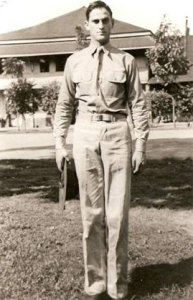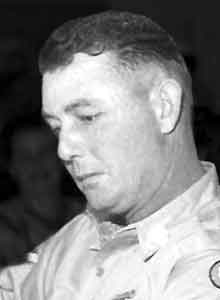Higgins, James J.
Army Private 1st class

James J. Higgins from Texas, Duval county.
Service era: World War II
Date of death: Thursday, April 9, 1942
Death details: Following the Allied surrender on the Bataan Peninsula on April 9, 1942, the Japanese began the forcible transfer of American and Filipino prisoners of war to various prison camps in central Luzon, at the northern end of the Philippines. The largest of these camps was the notorious Cabanatuan Prison Camp. At its peak, Cabanatuan held approximately 8,000 American and Filipino prisoners of war that were captured during and after the Fall of Bataan. Camp overcrowding worsened with the arrival of Allied prisoners who had surrendered from Corregidor on May 6, 1942. Conditions at the camp were poor, with food and water extremely limited, leading to widespread malnutrition and outbreaks of malaria and dysentery. By the time the camp was liberated in early 1945, approximately 2,800 Americans had died at Cabanatuan. Prisoners were forced to bury the dead in makeshift communal graves, often completed without records or markers. As a result, identifying and recovering remains interred at Cabanatuan was difficult in the years after the war. Private First Class James J. Higgins joined the U.S. Army from Texas and was a member of Company H of the 31st Infantry Regiment in the Philippines during World War II. He was captured in Bataan following the American surrender on April 9, 1942, and died of cerebral malaria on June 8, 1942, at the Cabanatuan Prison Camp in Nueva Ecija Province. He was buried in a communal grave in the camp cemetery along with other deceased American POWs; however, his remains could not be associated with any remains recovered from Cabanatuan after the war. Today, Private First Class Higgins is memorialized on the Walls of the Missing at the Manila American Cemetery in the Philippines.
Source: National Archives, Defense POW/MIA Accounting Agency
 Death details: On July 5, 1950, Task Force Smith, the first U.S. ground element to engage North Korean People’s Army (NKPA) troops, was defending a position north of Osan, South Korea. The Task Force’s goal was to delay enemy forces by blocking their movement down the road south from Suwon to Taejon, which was a major avenue of advance for the NKPA. That morning, the Task Force was engaged by a column of enemy tanks. The anti-tank weapons that the infantrymen employed were ineffective, and a large number of tanks broke through their position. Task Force Smith was forced to withdraw to the south, suffering heavy casualties in the process. Master Sergeant Harvey Thomas Vann, who joined the U.S. Army from Texas, served with C Company, 1st Battalion, 21st Infantry Regiment, 24th Infantry Division. His unit was part of Task Force Smith, and he was captured by enemy forces on July 5. He was marched to the Apex prison camps in North Korea, and died of exhaustion and pneumonia at the camp at Hanjang-ni in early January 1951. He was buried on a hillside just above the village; however, his remains were not identified among those returned to U.S. custody after the ceasefire. Today, Master Sergeant Vann is memorialized on the Courts of the Missing at the National Memorial Cemetery of the Pacific.
Death details: On July 5, 1950, Task Force Smith, the first U.S. ground element to engage North Korean People’s Army (NKPA) troops, was defending a position north of Osan, South Korea. The Task Force’s goal was to delay enemy forces by blocking their movement down the road south from Suwon to Taejon, which was a major avenue of advance for the NKPA. That morning, the Task Force was engaged by a column of enemy tanks. The anti-tank weapons that the infantrymen employed were ineffective, and a large number of tanks broke through their position. Task Force Smith was forced to withdraw to the south, suffering heavy casualties in the process. Master Sergeant Harvey Thomas Vann, who joined the U.S. Army from Texas, served with C Company, 1st Battalion, 21st Infantry Regiment, 24th Infantry Division. His unit was part of Task Force Smith, and he was captured by enemy forces on July 5. He was marched to the Apex prison camps in North Korea, and died of exhaustion and pneumonia at the camp at Hanjang-ni in early January 1951. He was buried on a hillside just above the village; however, his remains were not identified among those returned to U.S. custody after the ceasefire. Today, Master Sergeant Vann is memorialized on the Courts of the Missing at the National Memorial Cemetery of the Pacific.